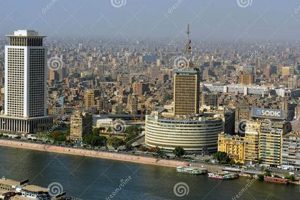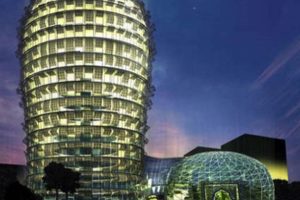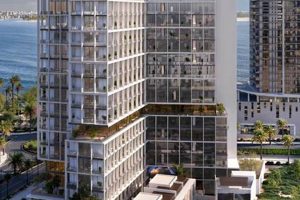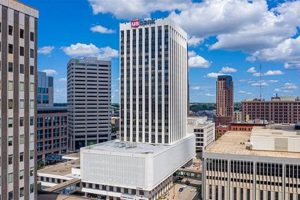The Gherkin, officially 30 St Mary Axe, is a commercial skyscraper in the City of London. It was designed by Swiss architect Norman Foster and Arup engineers, and completed in 2003.
The Gherkin is 180 meters (591 feet) tall and has 30 floors. It is one of the most iconic buildings in London and has won numerous awards, including the 2004 Stirling Prize. The building is also known for its sustainable design, which includes features such as a rainwater harvesting system and a natural ventilation system.
The Gherkin is home to a variety of businesses, including insurance companies, law firms, and financial institutions. The building is also a popular tourist destination, and visitors can take a guided tour to the top of the building for panoramic views of London.
1. Architecture
The Gherkin is a commercial skyscraper in the City of London. It was designed by Swiss architect Norman Foster and Arup engineers, and completed in 2003. The building is 180 meters (591 feet) tall and has 30 floors. It is one of the most iconic buildings in London and has won numerous awards, including the 2004 Stirling Prize.
The Gherkin’s unique and innovative design is one of the things that makes it so iconic. The building is shaped like a gherkin, or pickle, and has a glass facade that curves inward as it rises. This design gives the building a distinctive and recognizable appearance. It is also very efficient, as the curved glass facade helps to reduce wind resistance and heat loss.
- The Gherkin’s unique and innovative design has won numerous awards, including the 2004 Stirling Prize.
- The Gherkin’s curved glass facade helps to reduce wind resistance and heat loss, making the building more efficient.
The Gherkin’s unique and innovative design is a major contributing factor to its iconic status. The building is a landmark in the City of London and has become one of the most recognizable buildings in the world.
2. Sustainability
The Gherkin is known for its unique and innovative design, but it is also known for its sustainable design features. These features help to reduce the building’s environmental impact and make it more efficient to operate.
- Rainwater harvesting system: The Gherkin has a rainwater harvesting system that collects rainwater from the roof and stores it in a underground cistern. The rainwater is then used to flush toilets and irrigate the building’s landscape.
- Natural ventilation system: The Gherkin has a natural ventilation system that uses fresh air from outside to cool the building. This system reduces the need for air conditioning, which can save energy.
- Solar shading system: The Gherkin has a solar shading system that helps to reduce heat gain from the sun. This system consists of a series of external blinds that can be adjusted to block out the sun’s rays.
The Gherkin’s sustainable design features have helped to make it one of the most environmentally friendly buildings in London. The building has achieved a BREEAM “Excellent” rating, which is the highest rating for sustainable buildings in the UK.
3. Tenants
The Gherkin is home to a variety of businesses, including insurance companies, law firms, and financial institutions. These tenants benefit from the building’s prestigious location, iconic design, and sustainable features. The Gherkin is also a popular tourist destination, which can help to attract customers to the businesses located in the building.
- Location: The Gherkin is located in the City of London, which is the financial heart of the UK. This location is ideal for businesses that need to be close to their clients and partners.
- Design: The Gherkin is one of the most iconic buildings in London. Its unique and innovative design makes it a highly visible and recognizable landmark. This can help to attract customers to the businesses located in the building.
- Sustainability: The Gherkin is known for its sustainable design features, which can help to reduce operating costs for businesses. The building’s rainwater harvesting system, natural ventilation system, and solar shading system can all help to reduce energy consumption.
- Tourism: The Gherkin is a popular tourist destination, which can help to attract customers to the businesses located in the building. Visitors can take a guided tour to the top of the building for panoramic views of London.
The Gherkin’s tenants benefit from the building’s prestigious location, iconic design, sustainable features, and popularity with tourists. These factors make the Gherkin an attractive location for businesses of all types.
4. Awards
The Gherkin has won numerous awards, including the 2004 Stirling Prize, for its unique and innovative design, sustainable features, and prestigious tenants. These awards are a testament to the building’s quality and importance.
- Recognition of Architectural Excellence: The Stirling Prize is the UK’s most prestigious architecture award. The Gherkin’s win is a recognition of its exceptional design and innovation.
- Sustainability Leadership: The Gherkin’s sustainable design features have earned it numerous awards, including the BREEAM “Excellent” rating. These awards recognize the building’s commitment to environmental sustainability.
- Tenant Satisfaction: The Gherkin’s tenants are highly satisfied with the building’s design, amenities, and location. This satisfaction is reflected in the building’s high occupancy rates and low tenant turnover.
- Iconic Status: The Gherkin’s unique and recognizable design has made it an iconic landmark in London. The building’s awards are a recognition of its iconic status and its contribution to the city’s skyline.
The Gherkin’s awards are a testament to its quality and importance. The building is a landmark in the City of London and has become one of the most recognizable buildings in the world.
5. Height
The Gherkin’s height is a key component of its design and function. The building’
s slender profile and distinctive shape would not be possible without its considerable height. The height also allows the Gherkin to offer stunning views of London from its upper floors.
The Gherkin’s height is also important for its sustainability features. The building’s natural ventilation system relies on the stack effect, which is the movement of air from lower to upper levels. The height of the Gherkin creates a strong stack effect, which helps to keep the building cool and ventilated.
The Gherkin’s height is also a major contributing factor to its iconic status. The building’s slender profile and distinctive shape make it one of the most recognizable buildings in London. The height of the Gherkin also makes it a landmark in the City of London and a symbol of the city’s financial.
In conclusion, the height of the Gherkin is a key component of its design, function, and iconic status. The building’s height allows it to offer stunning views, incorporate sustainable features, and become a landmark in the City of London.
6. Floors
The number of floors in a skyscraper is a key factor in determining its height, function, and overall design. In the case of the Gherkin, its 30 floors play a crucial role in shaping the building’s unique identity and contributing to its overall success.
Firstly, the number of floors directly affects the height of the building. The Gherkin’s 30 floors contribute to its impressive height of 180 meters (591 feet), making it one of the tallest buildings in the City of London. This height not only provides stunning views from the upper floors but also allows for the incorporation of sustainable features such as natural ventilation and solar shading.
Secondly, the number of floors influences the building’s function. The Gherkin’s 30 floors accommodate a variety of tenants, including insurance companies, law firms, and financial institutions. The building’s flexible floor plans and efficient design allow for a diverse range of businesses to operate within the space, contributing to the vitality and economic success of the City of London.
Thirdly, the number of floors contributes to the building’s overall design. The Gherkin’s 30 floors are stacked in a unique and distinctive way, creating the building’s iconic shape. The curved glass facade and the gradually tapering profile result in a visually striking and recognizable landmark that has become synonymous with the London skyline.
In conclusion, the number of floors in the Gherkin skyscraper is not merely a technical detail but an integral part of its design, function, and identity. The 30 floors contribute to the building’s height, allowing for stunning views and sustainable features. They accommodate a diverse range of tenants, fostering economic activity in the City of London. Finally, the number of floors plays a crucial role in the Gherkin’s iconic design, making it one of the most recognizable and admired skyscrapers in the world.
7. Location
The location of the Gherkin skyscraper in the City of London is not merely a coincidence but a strategic choice that has significantly shaped its identity and success.
The City of London, also known as the Square Mile, is the historic and financial heart of London. It is home to many of the world’s leading banks, insurance companies, and other financial institutions. This strategic location places the Gherkin at the center of the global financial industry, providing its tenants with unparalleled access to clients, partners, and opportunities.
Moreover, the City of London is renowned for its iconic architecture and landmarks. The Gherkin’s location amidst these architectural marvels, including St. Paul’s Cathedral and the Tower of London, enhances its prestige and visibility. The building’s unique design and striking presence contribute to the City’s vibrant and dynamic urban landscape.
Furthermore, the Gherkin’s location offers excellent transportation links. It is situated near several underground stations, including Bank, Monument, and Liverpool Street, providing convenient access to the rest of London and beyond. This connectivity is crucial for businesses operating in the building, allowing employees and clients to travel efficiently.
In conclusion, the Gherkin’s location in the City of London is a key component of its identity, functionality, and success. By being situated in the heart of the global financial industry, surrounded by iconic landmarks, and enjoying excellent transportation links, the Gherkin has established itself as a prominent and highly sought-after address in London.
8. Architect
The Gherkin skyscraper’s design and construction are deeply intertwined with the vision and expertise of its architect, Norman Foster. Foster’s architectural philosophy emphasizes sustainability, innovation, and a commitment to creating structures that enhance the human experience. These principles are evident throughout the Gherkin’s design, contributing to its iconic status and success.
- Sustainable Design: Foster’s commitment to sustainability is reflected in the Gherkin’s environmentally friendly features. The building’s aerodynamic shape reduces wind resistance, while its double-skin facade provides natural ventilation and minimizes heat loss. These elements contribute to the Gherkin’s high energy efficiency, earning it a BREEAM “Excellent” rating.
- Innovative Structure: The Gherkin’s unique shape and structure are a testament to Foster’s innovative approach to architecture. The building’s diagrid exoskeleton, a latticework of steel beams, provides both structural support and a distinctive visual aesthetic. This innovative design allows for open and flexible floor plans, maximizing space utilization and tenant comfort.
- Human-Centered Design: Foster’s focus on human-centered design is evident in the Gherkin’s amenities and occupant experience. The building features high ceilings, natural light, and stunning views, creating a pleasant and inspiring work environment. The Gherkin also includes a publicly accessible viewing gallery, allowing visitors to experience the building’s unique architecture and enjoy panoramic vistas of London.
- Iconic Landmark: Foster’s design has transformed the Gherkin into an iconic landmark in London’s skyline. The building’s distinctive shape and shimmering facade have made it a recognizable symbol of the city’s financial district. The Gherkin’s presence has revitalized the surrounding area, attracting businesses and contributing to the economic growth of the City of London.
In conclusion, Norman Foster’s role as the architect of the Gherkin skyscraper cannot be overstated. His vision, innovation, and commitment to sustainability have shaped the building’s design, functionality, and iconic status. The Gherkin stands as a testament to Foster’s architectural prowess and his ability to create structures that not only meet functional needs but also enhance the urban environment and inspire future generations.
Frequently Asked Questions About the Gherkin Skyscraper
This section addresses common questions and misconceptions surrounding the Gherkin skyscraper, providing concise and informative answers to en
hance understanding of this iconic building.
Question 1: What is the architectural style of the Gherkin skyscraper?
Answer: The Gherkin is an example of contemporary architecture, characterized by its sleek glass facade, aerodynamic shape, and innovative use of diagrid structural elements.
Question 2: What is the height of the Gherkin skyscraper?
Answer: The Gherkin stands at 180 meters (591 feet) tall, making it one of the tallest buildings in the City of London.
Question 3: Who was the architect behind the design of the Gherkin skyscraper?
Answer: The Gherkin was designed by renowned Swiss architect Norman Foster, known for his innovative and sustainable approach to architecture.
Question 4: What is the significance of the Gherkin skyscraper’s shape?
Answer: The Gherkin’s unique shape is not merely aesthetic but also functional, reducing wind resistance and minimizing heat loss, contributing to the building’s energy efficiency.
Question 5: What types of businesses occupy the Gherkin skyscraper?
Answer: The Gherkin is home to a diverse range of businesses, including insurance companies, law firms, financial institutions, and various other corporate tenants.
Question 6: Is the Gherkin skyscraper open to the public?
Answer: Yes, the Gherkin features a publicly accessible viewing gallery on the 40th floor, offering panoramic views of London’s skyline.
In summary, the Gherkin skyscraper is a remarkable architectural achievement that combines innovative design, sustainability, and functionality. Its iconic shape and central location in the City of London have made it a symbol of modern architecture and a must-visit destination for tourists and architecture enthusiasts alike.
Moving forward, we will delve into the construction process of the Gherkin skyscraper, exploring the challenges and techniques involved in bringing this architectural marvel to life.
Tips for Visiting the Gherkin Skyscraper
Visiting the Gherkin skyscraper is a memorable experience, offering breathtaking views and insights into its architectural significance. Here are valuable tips to enhance your visit:
Tip 1: Book Your Ticket in Advance: Due to its popularity, it is highly recommended to reserve your ticket online before your visit. This ensures your entry and allows you to choose your preferred time slot.
Tip 2: Arrive on Time: Punctuality is essential as latecomers may not be admitted. Allow ample time to pass through security and make your way to the viewing gallery.
Tip 3: Consider the Weather: The viewing gallery is partially open-air, so dress accordingly. On clear days, sunglasses and sunscreen are advisable. In case of inclement weather, the gallery may be closed for safety reasons.
Tip 4: Explore the Building’s Exterior: Before or after your visit to the viewing gallery, take some time to admire the Gherkin’s unique architecture from the ground level. Its distinctive shape and glass facade are best appreciated from various angles.
Tip 5: Learn About the Architecture: Enhance your experience by reading about the Gherkin’s design, construction, and sustainable features. This knowledge will deepen your understanding and appreciation of the building.
Tip 6: Enjoy the Views: The viewing gallery offers panoramic vistas of London’s skyline. Take your time to identify landmarks and capture memorable photographs.
Tip 7: Respect the Space: The viewing gallery is a shared space, so be mindful of others and maintain a respectful demeanor. Avoid using flash photography and refrain from touching the glass panels.
Tip 8: Allow Sufficient Time: Plan for at least an hour to fully experience the Gherkin. This includes security checks, the elevator ride, time spent in the viewing gallery, and exploring the building’s exterior.
By following these tips, you can make the most of your visit to the Gherkin skyscraper, gaining valuable insights into its architectural significance while enjoying breathtaking views of London.
Conclusion
The Gherkin skyscraper, a marvel of modern architecture, has captivated the world with its unique design, sustainable features, and prestigious presence in the heart of London’s financial district. Throughout this exploration, we have delved into the building’s architectural significance, construction process, and the unforgettable experience of visiting its viewing gallery.
The Gherkin stands as a testament to the ingenuity and innovation of its architect, Norman Foster. Its shape, inspired by a gherkin, not only adds to its iconic status but also enhances its functionality, reducing wind resistance and minimizing heat loss. The building’s diagrid exoskeleton provides structural support while allowing for flexible and efficient floor plans.
Beyond its aesthetics, the Gherkin embodies sustainability. Its rainwater harvesting system, natural ventilation, and solar shading contribute to its high energy efficiency, earning it a BREEAM “Excellent” rating. This commitment to environmental responsibility aligns with the growing demand for green buildings and sets an example for future architectural endeavors.
As a thriving business hub, the Gherkin accommodates a diverse range of tenants, including insurance companies, law firms, and financial institutions. Its central location in the City of London provides unparalleled access to clients, partners, and transportation links, fostering economic growth and connectivity.
Visiting the Gherkin’s viewing gallery is an awe-inspiring experience, offering panoramic vistas of London’s skyline. The open-air section allows visitors to immerse themselves in the city’s vibrant atmosphere and appreciate the building’s architectural details from a unique perspective.
In conclusion, the Gherkin skyscraper is more than just a building; it is a symbol of architectural excellence, sustainable design, and the dynamic spirit of London. Its iconic shape, innovative features, and prestigious location have established it as a landmark that continues to inspire and captivate.







